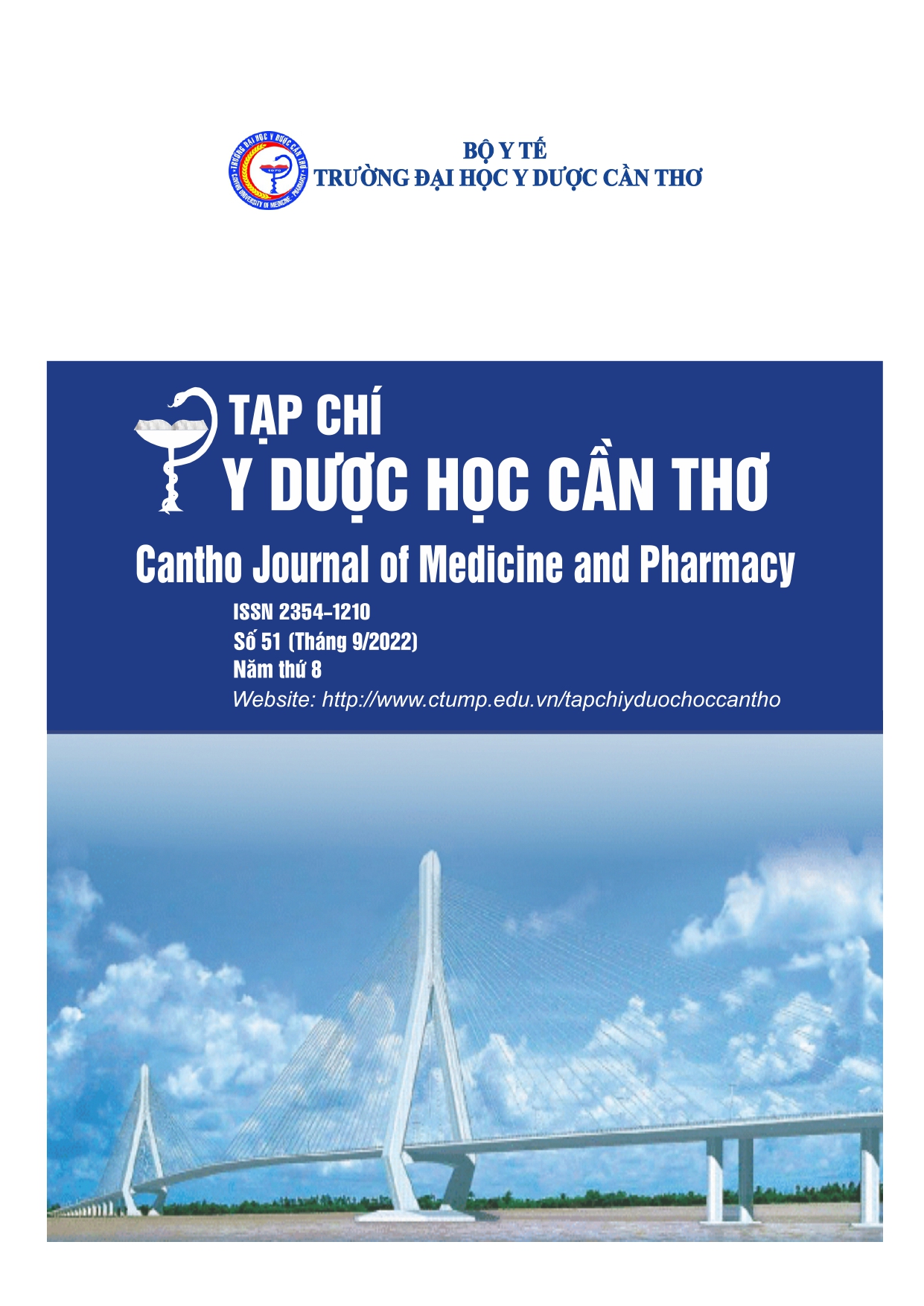LAPAROSCOPIC TOTALLY EXTRAPERITONEAL REPAIR FOR INGUINAL HERNIA IN PATIENTS OVER 40 YEARS OLD IN 2020 – 2022
Main Article Content
Abstract
Background: Inguinal hernia is a common surgical condition with many methods of treatment including open surgery and laparoscopic one. At Can Tho, the laparoscopic totally extraperitoneal repair for inguinal hernia in patients over 40 years old has not been adequately studied. Therefore, this study was conducted. Objectives: 1. To determine clinical and subclinical features, classification of inguinal hernia in patients over 40 years old; 2. To evaluate the results of the laparoscopic totally extraperitoneal repair for inguinal hernia in patients over 40 years old at Can Tho University of Medicine and Pharmacy Hospital and Can Tho General Hospital. Materials and methods: This was a prospective, cross-sectional study on 80 patients over 40 years old with inguinal hernias who underwent laparoscopic totally extraperitoneal repair. Results: The mean age of patients was 59.1 ± 11.6 years old. Bilateral inguinal hernia were 11.2%, on right side were 52.5%, on left side were 36.3%. 81.3% were indirect inguinal hernia, 12.5% were direct and 6.2% were combined. Mean operating time was 60.3 ± 21.3 minutes. The rate of peritoneal tear was 3.8%, inferior epigastric artery injury was 1.2%. The mean time of hospital stay was 2.3 ± 0.8 days. Assessment of early results: very good, good and average accounted for 36.3%, 61.2% and 2.5%, respectively. Assessment of late results after 12 months: very good and good accounted for 97.5% and 2.5%, respectively. Conclusion: Laparoscopic totally extraperitoneal repair for inguinal hernia in patients over 40 years old is a safe and effective.
Article Details
Keywords
Inguinal hernia, patients over 40 years old, laparoscopic totally extraperitoneal repair
References
2. Phan Đình Tuấn Dũng (2017), Nghiên cứu ứng dụng phẫu thuật nội soi ngoài phúc mạc với tấm lưới nhân tạo 2D và 3D trong điều trị thoát vị bẹn trực tiếp, Luận văn Tiến sĩ Y học, Trường Đại học Y Dược Huế.
3. Vương Thừa Đức, Dương Ngọc Thành (2011), “Đau mạn tính vùng bẹn đùi sau mổ thoát vị bẹn”, Tạp chí Y Dược học Thành phố Hồ Chí Minh, 15(1), 115-123.
4. Nguyễn Văn Liễu (2004), Nghiên cứu ứng dụng phẫu thuật Shouldice trong điều trị thoát vị bẹn, Học viện Quân Y Hà Nội.
5. Trần Đỗ Nhân (2017), Đánh giá kết quả phẫu thuật nội soi đặt tấm lưới nhân tạo ngoài phúc mạc ở bệnh nhân thoát vị bẹn theo thang điểm Carolinas, Luận văn Chuyên khoa cấp II, Trường Đại học Y Dược Huế.
6. Lê Quốc Phong (2015), Đánh giá kết quả ứng dụng đặt tấm lưới nhân tạo theo phương pháp Lichtenstein điều trị thoát vị bẹn ở bệnh nhân từ 40 tuổi trở lên, Luận văn Tiến sĩ Y học, Trường Đại học Y Dược Huế.
7. Đỗ Mạnh Toàn (2019), Nghiên cứu ứng dụng phẫu thuật nội soi qua ổ phúc mạc đặt lưới nhân tạo điều trị thoát vị bẹn tại Bệnh viện Hữu nghị Việt Đức, Luận văn Tiến sĩ Y học, Trường Đại học Y Dược Hà Nội.
8. Trần Thanh Tuấn (2019), Nghiên cứu đặc điểm lâm sàng, hình ảnh siêu âm và đánh giá kết quả sớm điều trị thoát vị bẹn bằng phương pháp đặt tấm lưới nhân tạo 3D nội soi ngoài phúc mạc tại Bệnh viện Đa khoa Thành phố Cần Thơ năm 2018 – 2019, Luận văn Chuyên khoa cấp II, Trường Đại học Y Dược Cần Thơ.
9. Ghazzal A., Qatawnech T., Abusiene A. (2012), “Total extra peritoneal laparoscopic inguinal hernioplasty: Early experience at the royal medical services hospitals of Jorrdan Armed forrces”, Journal of the royal medical services, 18(2), 5-10.
10. HerniaSurge Group (2018), “International guidelines for groin hernia management”, Hernia, 22(1), 1-165.
11. Kalwaniya D.S., et al. (2019), “Subcutaneous emphysema following laparoscopic totally extraperitoneal inguinal hernia repair - a case series”, International Journal of Current Advanced Research, 8(11), 18527-18530.
12. Mahroos M.A., Vassiliou M. (2017), “Laparoscopic Totally Extraperitoneal (TEP) Inguinal Hernia Repair”, Texbook of Hernia, Springer International, Switzerland, 99-107.
13. McKernan Barry J., Henry Laws L. (1993), “Laparoscopic repair of inguinal hernias using a totally extraperitoneal prosthetic approach”, Surg Endosc, 7, 26-28.
14. Peacock E., Madden W. (1974), “Studies on the Biology and Treatment of Recurrent Inguinal Hernia”, Ann. Surg. , 179(5), 567-571.
15. Zhou Xue-Lu, et al. (2021), “Totally Extraperitoneal Herniorrhaphy (TEP): Lessons Learned from Anatomical Observatio”, Minimally Invasive Surgery, 1-8.


